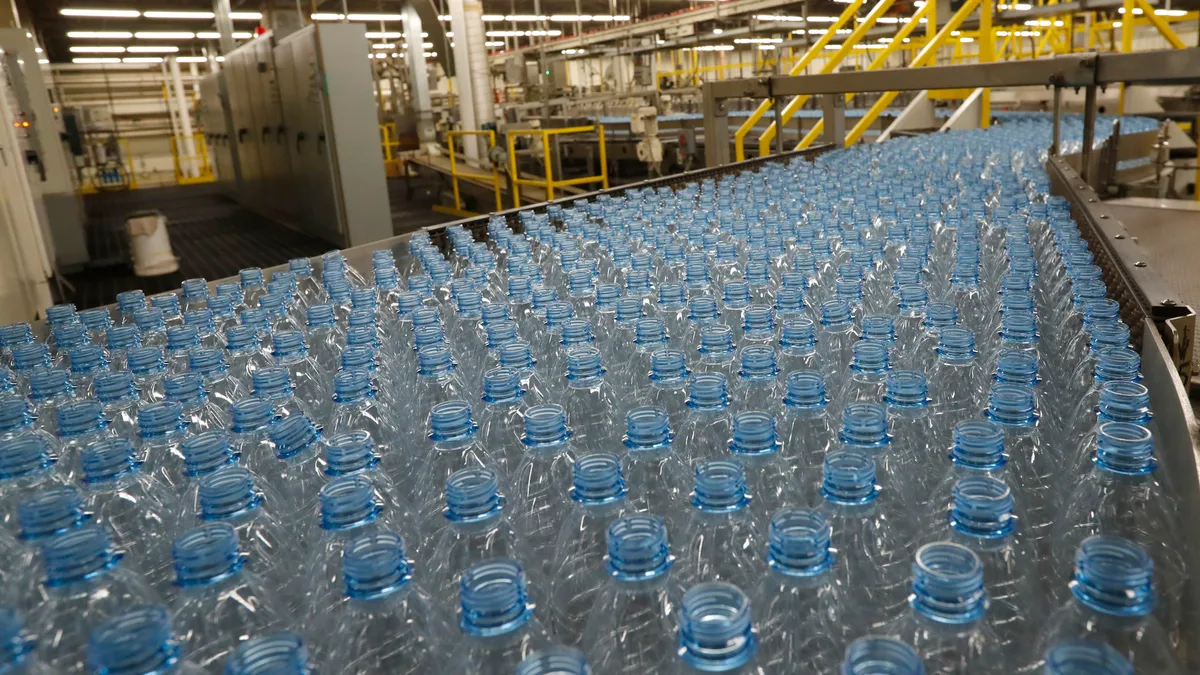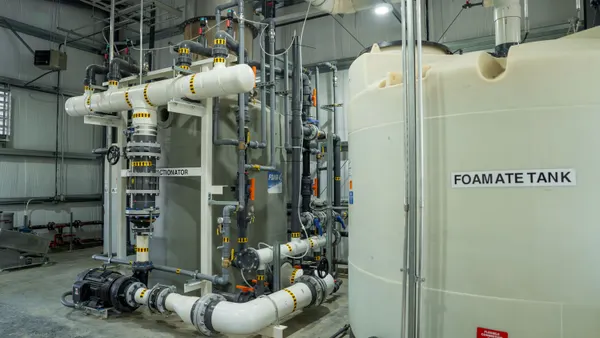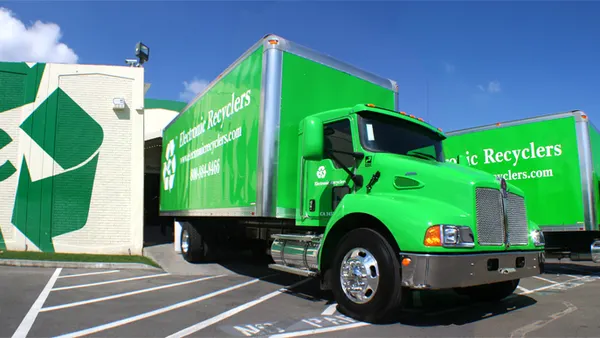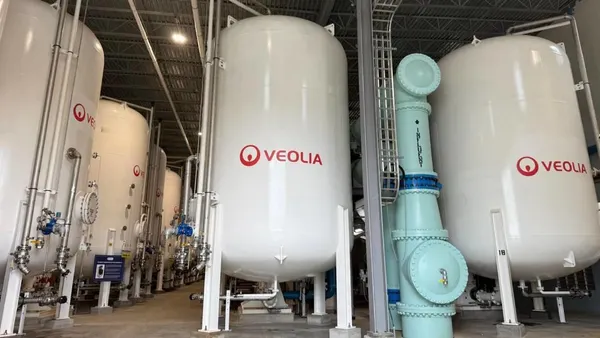Dive Brief:
- A report published Thursday from Beyond Plastics, a nonprofit working to end single-use plastic pollution, finds that the U.S. plastics industry is the source of 232 million tons of greenhouse gases per year, 15 million tons of which comes from burning plastics in municipal waste.
- “We are in a climate crisis,” said Judith Enck, founder and president of Beyond Plastics. “If we have any hope of effectively driving down greenhouse gas emissions, the production and use and disposal of plastics has to be on the agenda.”
- The authors compare the rapid buildout of U.S. plastics production infrastructure with the gradual phaseout of coal power plants, finding that the emissions from plastics could exceed those from coal in the United States by 2030.
Dive Insight:
This report comes when many countries are gearing up to deliver their greenhouse gas emissions reductions goals at the international COP26 climate summit. If plastic production emissions increase, advocates warn, it could negate the progress made on other fronts.
The report examines the emissions from plastics across their entire life cycle, from fracking to their end of life in municipal waste or as litter. Researchers identified over 100 current and planned plastic production facilities in the United States and used data provided to the U.S. government to identify their greenhouse gas contributions.
The Plastics Industry Association (PLASTICS) took issue with the report in a statement released Thursday, calling it “misguided.” The industry group cited research from the Imperial College of London that found plastic requires less fuel to transport than alternatives.
“Lighter products require less fuel to transport. That’s a fact,” George O’Connor, associate director of communications for PLASTICS, wrote in an email.
The Beyond Plastics report did not directly address the greenhouse gas emissions associated with the transportation of plastic products, though it did note that transporting ethane gas, a vital building block in the U.S. plastic production process, emits 5 million tons of greenhouse gases per year.
Using U.S. EPA data, the report’s authors, led by environmental research agency Material Research, found that incinerating plastics in municipal waste facilities across the U.S. emits an estimated 15 million tons of greenhouse gases, the equivalent of seven average-sized coal power plants. About 12% of all municipal waste in the United States was incinerated in 2018, according to EPA data, and an estimated 15.8% of plastics generated ended up in such facilities that year.
The report also notes that the average proportion of plastic in municipal waste streams has increased steadily over the years, doubling from 1990 to 2018, when it reached 17% of municipal waste by weight, according to EPA data. While some of the shift comes from a decline in certain paper products, over that time period the total tonnage of plastic products in municipal solid waste grew from 17.1 million to 35.7 million.
The researchers also looked at chemical recycling and pyrolysis as proposed solutions to plastic waste. According to the report’s authors, if current planned projects are completed, the emissions from chemical recycling would add 18 million tons of greenhouse gas emissions annually by 2025.
The American Chemistry Council, a key backer of such technologies, also took issue with the report generally and said it “neglects the importance of advanced recycling to creating a more circular economy.” Prior reports from environmental groups note many chemical recycling facilities may be more focused on turning plastics into fuels than on turning them into monomers for new products.
Enck, a former EPA official, said chemical recycling was little more than a ploy for the fossil fuel industry to continue pumping out plastic products. The report cites a December 2020 analysis from the EPA which found that of the 35 U.S. gasification or pyrolysis projects announced in the United States, just six were still operating at a commercial or demonstration scale.
“The big move by the chemical industry now is to finally admit that plastics recycling has been a failure because it comes in at an anemic 8.5% recycling rate,” Enck said. “They're now shifting to a new deception, which is saying chemical recycling is the solution.”
Steven Feit, an attorney in the Center for International Environmental Law’s Climate and Energy Program, helped produce a report in 2019 that estimated the total global greenhouse gas emissions from plastics. The report found that worldwide, the entire plastic life cycle contributed 850 million metric tons of greenhouse gas emissions in 2019.
Feit praised the new report from Beyond Plastics, saying it provides important data for advocates looking to understand the true climate impact of plastic production at a more granular level.
“One of the challenges with plastic is that if you only look at one slice of things, you can miss what's happening in the whole supply chain and you can end up shifting around a problem rather than solving it,” Feit said.
Dealing with the plastics already in the supply chain is a difficult challenge, Feit said. He is one of many advocates who have called on Congress to “turn off the tap” of plastic production. He supports the proposed Break Free From Plastic Pollution Act, which does not include pyrolysis as a form of recycling and would phase out certain single-use plastic products.
That bill, which has yet to gain traction in Congress, would mandate fence-line monitoring of air quality for covered facilities like waste incinerators. It would also pause the approval of any new covered facilities near frontline communities — defined as communities that have experienced systemic socioeconomic disparities or other forms of injustice — until funding goals for recycling infrastructure are met.
The bill’s mandates are in line with the demands of advocates and researchers critical of the broader waste infrastructure. They cite data like that in a 2019 report, which found that nearly 80% of waste incinerators were located near marginalized communities, as a sign of disparate impact.
“From a pollution and environmental justice perspective, there's a bunch of these facilities... it's not an abstract, diffuse thing,” Feit said. “Incineration and landfilling are happening in really specific places.”
Enck also decried the environmental justice impacts of plastic production, saying the new emissions research was yet another link between plastic waste and climate change.
“What we have seen over the past few years especially is this growing understanding that plastics are a fossil fuel in another form,” Enck said. “The plastics crisis is the climate crisis, and the climate crisis is the plastics crisis."











